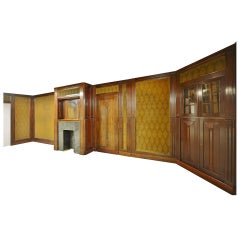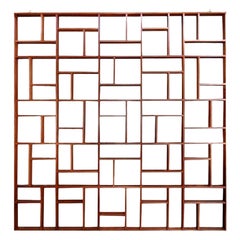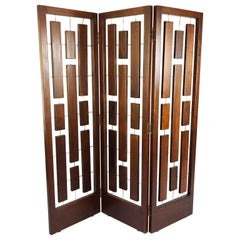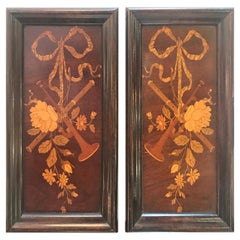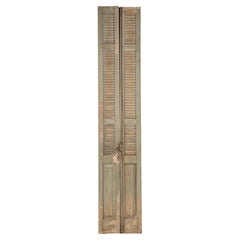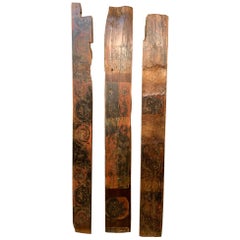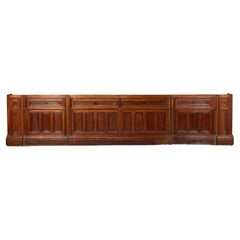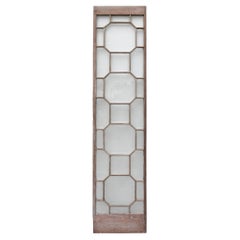Mahogany Panelling
to
1
5
2
7
1
Height
to
Width
to
2
1
1
1
2
5
1
3
1
1
20,798
218
66
40
35
5
2
2
2
1
8
7
8
1
1
Material: Mahogany
Mahogany and Fabric Panelled Room, Designed by Jac. van den Bosch
Located in Haarlem, Noord-Holland
A rare opportunity to acquire this exquisite panelled room with original wall fabric, circa 1912.
This room was designed by Jac. van den Bosch (1868-1948), the wall fabric was design...
Category
20th Century Dutch Mahogany Panelling
Materials
Fabric, Mahogany
Custom Mid-Century Style Geometric Wood Room Divider by Adesso Imports
Located in Los Angeles, CA
Mid-century geometric wood room divider. Made in Los Angeles by Adesso Imports.
Custom sizing and pricing available upon request.
Category
2010s American Mid-Century Modern Mahogany Panelling
Materials
Mahogany
Art Nouveau mahogany woodwork from Café Barjot in Paris, 1905
Located in SAINT-OUEN-SUR-SEINE, FR
This woodwork characteristic of the Art Nouveau style comes from the Café Barjot located avenue Ledru-Rollin in the 12th district of Paris, it was made in 1905. It is composed on a f...
Category
Early 20th Century French Art Nouveau Mahogany Panelling
Materials
Wood, Mahogany, Stained Glass
Pair of Reclaimed Carved Mahogany Pilasters
Located in Wormelow, Herefordshire
A handsome pair of late 19th/early 20th century reclaimed carved mahogany pilasters with French polish finish. These are just two of a series of architectural elements reclaimed from...
Category
Early 20th Century English Georgian Mahogany Panelling
Materials
Wood, Mahogany
Folding Screen Room Divider in Solid Mahogany
Located in Mexico City, CDMX
We offer this folding screen made in solid frames of mahogany wood with brass details, circa 1950.
Category
1950s Mexican Mid-Century Modern Vintage Mahogany Panelling
Materials
Mahogany
19th Century Diminutive Inlaid Wood Framed Panels
Located in Lambertville, NJ
A pair of diminutive mahogany and satinwood inlaid framed panels. The wood panels with inlays of kings wood, tulip wood and satin wood with floral and in...
Category
1880s European Victorian Antique Mahogany Panelling
Materials
Mahogany
$713 Sale Price / set
24% Off
Length of Mahogany Wall Panelling
Located in Wormelow, Herefordshire
Length of Mahogany wall panelling. Double sided, nicely figured panels. Original finish, this would be ideal as a room divider.
Additional dimensions
Depth 3 – 9 cm.
Category
Early 20th Century Mahogany Panelling
Materials
Mahogany
Victorian Reclaimed Mahogany Counter or Bar Panelling
Located in Wormelow, Herefordshire
Three sections of reclaimed Victorian mahogany bar counter panelling.
Additional Dimensions:
2 panels- 96 x 108 x 4 cm
1 panel- 94 x 76 x 4 cm
Category
Late 19th Century English Antique Mahogany Panelling
Materials
Mahogany, Wood
Related Items
Pair of Antique French Shutter in Old Crumbly Paint From a Chateau in Brittany
Located in BENSENVILLE, IL
Antique pair of French shutters in very old paint removed a long time ago from a chateau located in Brittany.
**Width provided is for the wider shutte...
Category
1880s French Country Antique Mahogany Panelling
Materials
Wood, Paint
$450 / set
H 119 in W 11.38 in D 1.75 in
Outstanding Set of 3 16th Century Spanish Ceiling Panels, Beams
Located in Round Top, TX
An outstanding and exceptional set of 3 16th century ceiling panels - beams from Barcelona. Hand hewn solid wood panels beautifully painted. Fabulous architectural elements to incorp...
Category
16th Century Spanish Antique Mahogany Panelling
Materials
Wood
$8,950 / set
H 10 in W 92.5 in D 1.5 in
Matte White Brutalist Sculptural Collage Artwork, Mural from Upcycled Wood
Located in San Antonio, TX
These MATTE WHITE collage tiles are composed randomly from recycled wood remnants and when installed bathe any space with a warm feeling and texture which...
Category
2010s Mexican Brutalist Mahogany Panelling
Materials
Wood
$74 / item
H 23.5 in W 23.5 in D 2 in
An antique framed wood carving, 19th century
Located in View Park, CA
A stunning and unique fine artwork that features an antique wood carving - seemingly depicting a medieval knight on horseback - set against a silken silver matting and centered in an...
Category
19th Century Unknown Medieval Antique Mahogany Panelling
Materials
Linen, Wood
Pair of English Gothic Revival Oak Railings
Located in Queens, NY
Pair of English Gothic Revival style (19th Century) oak carved railing panels with open design and finial (PRICED AS Pair).
Category
19th Century British Gothic Revival Antique Mahogany Panelling
Materials
Oak
19th c. Chicago Stock Exchange Building Molding Fragment Architectural Element
Located in Forney, TX
A rare and important hand painted plaster decorative molding fragment, by Louis H. Sullivan (American, 1856-1924), from the interior of the Chicago Stock Exchange, circa 1893-1894.
...
Category
19th Century American Industrial Antique Mahogany Panelling
Materials
Plaster, Paint
$1,500
H 2 in W 10.5 in D 1.5 in
19th Century Walnut Pair of Bookcases Boiserie de Bibliothèque
Located in Vosselaar, BE
A rare pair of heliocodal French Directoire library bookcases in solid walnut. This type of bookcases is also known as 'boiseries de Bibliothèque' a...
Category
Early 19th Century French Empire Antique Mahogany Panelling
Materials
Walnut
$101,616
H 101.19 in W 137.8 in D 19.3 in
Late 19th Century French Art Nouveau Double Doors, Set of 3
Located in Dusseldorf, DE
Rare set consisting of 3 identical French Art Nouveau double doors from around 1900. Unrestored condition.
Solidly made of pine wood in frame construction with 3 panels each and p...
Category
Late 19th Century French Art Nouveau Antique Mahogany Panelling
Materials
Pine
$6,931 / set
H 110.24 in W 51.19 in D 1.38 in
Set of Two Large French 19th Century Curved Hand Carved Walnut Panels
Located in Santa Monica, CA
Set of two large French 19th century curved hand carved walnut panels.
Category
Late 19th Century French Antique Mahogany Panelling
Materials
Walnut
$1,438 Sale Price / set
40% Off
H 102 in W 17 in D 3.5 in
Paneled Room with a Neo-Classical Decor, Louis XVI Period
Located in SAINT-OUEN-SUR-SEINE, FR
This beautiful paneled room is composed of elements from the Louis XVI period on a pine tree structure, some elements have been put on more recent frame from the 20th century beginning.
It shows a white painted paneled decor...
Category
20th Century French Louis XVI Mahogany Panelling
Materials
Wood
17th Century French Renaissance Hand-Carved Front Section of a Built in Cabinet
Located in Casteren, NL
This beautiful carved Renaissance front section was a part of a built in cabinet.
The carvings are typical for Bretagne area in France and it can be ...
Category
Mid-17th Century French Renaissance Antique Mahogany Panelling
Materials
Oak
$2,677 Sale Price
50% Off
H 48.43 in W 68.9 in D 4.34 in
19th Century Indian Carved Panel with Shutter Windows
Located in Rio Vista, CA
Fantastic 19th century Indian wall panel with two sets of shutter windows. Features a highly carved front with a blossom or starburst motif. On top a...
Category
19th Century Indian Anglo-Indian Antique Mahogany Panelling
Materials
Brass
Previously Available Items
Large Reclaimed Victorian Mahogany Bar Front
Located in Wormelow, Herefordshire
A large reclaimed Victorian mahogany bar front. Dating to circa 1880, the handsome fluted panelled front is complimented by decorative roundels and an original French polish finish. ...
Category
Late 19th Century English Victorian Antique Mahogany Panelling
Materials
Wood, Mahogany
Georgian Style Glass Panel with Astral Glazing
Located in Wormelow, Herefordshire
A classy and stylish mahogany and glass panel dating from the late 1880s. Though originating from the Victorian era, this handsome panel is a supremely stylish addition to a 21st century home with its impressive geometric design known as astral glazing...
Category
Late 19th Century English Georgian Antique Mahogany Panelling
Materials
Glass, Mahogany
Reclaimed Mahogany Wall Panel
Located in Wormelow, Herefordshire
Reclaimed Mahogany wall panel. The panel comes with book matched veneer panels. This would make a wonderful head board, even a grand menu or notice board ...
Category
Early 20th Century Mahogany Panelling
Materials
Wood, Mahogany
Reclaimed Mahogany Dado Height Wall Panelling
Located in Wormelow, Herefordshire
18.6 m Run of antique Mahogany dado height wall panelling with original French Polish finish.
Lovely quality panelling with original skirting and rail.
Additional Dimensions
...
Category
19th Century Antique Mahogany Panelling
Materials
Mahogany
Antique Mahogany Bar Panelling
Located in Wormelow, Herefordshire
Reclaimed Mahogany bar or counter front panelling, in two pieces, with a circle design in the centre.
Additional dimensions
Width 242, 210 cm
Depth between 4 cm and 12 cm.
Category
Mid-20th Century Mahogany Panelling
Materials
Mahogany
Large Reclaimed ‘King’ Wall Hanging Sign
Located in Wormelow, Herefordshire
A large reclaimed ‘King’ wall hanging sign dating to the early 20th century. Bold and stylish cast bronze letters are mounted onto a smooth mahogany boa...
Category
Early 20th Century English Empire Mahogany Panelling
Materials
Bronze
Mexican Modernist Magnificent Mahogany and Brass Escudero Room Divider Screen
Located in Chula Vista, CA
We are pleased to present: Mexican modernist magnificent mahogany and brass room divider screen privacy panel.
Eugenio Escudero attribution, custom studio piece. No label present fr...
Category
1960s Mexican Mid-Century Modern Vintage Mahogany Panelling
Materials
Mahogany
H 102.5 in W 82 in D 1.75 in
Mahogany Dado Wall Panelling
Located in Wormelow, Herefordshire
About:
A 15.7 linear meters run of antique mahogany wall panelling. There are 9 main panelling pieces with additional skirting and moulding for the top edge. Reclaimed from a prop...
Category
Late 19th Century European Antique Mahogany Panelling
Materials
Mahogany
Pair of Late 19th Century Carved Mahogany Gargoyle Panels
Located in Brooklyn, NY
Pair of late 19th Century, relief carved, mahogany panels emanating from a gargoyle head.
Category
Late 19th Century American Gothic Revival Antique Mahogany Panelling
Materials
Mahogany
Library Panels, Late 19th c
Located in San Marino, CA
A pair of library wall panels, each with nine solid mahogany panels.
Each panel: 92 1/4 w x 116 1/4h(add 2 1/2” to outer ends for cr...
Each panel: 92 1/4 w x 116 1/4h(add 2 1/2” to outer ends for cr...
Category
19th Century Antique Mahogany Panelling
Materials
Mahogany
Still Thinking About These?
All Recently ViewedMore Ways To Browse
Nena Claiborne
Retro Wall Panelling
Antique Altar Panel
Paravent Coromandel
Vince Camuto
Reclaimed Paneling
French 4 Drawer Chest
French Antique Storage Box
French Provincial Breakfront
French Waiter
Galle Cabinet
Glass Store Cabinets
Glazed Mahogany Display Cabinet
Gold Accent Cabinet
Gustavian Cabinet Glass
Hand Carved Wood Hooks
Hanging Hand Carved Cabinet
Hollywood Glam Furniture
